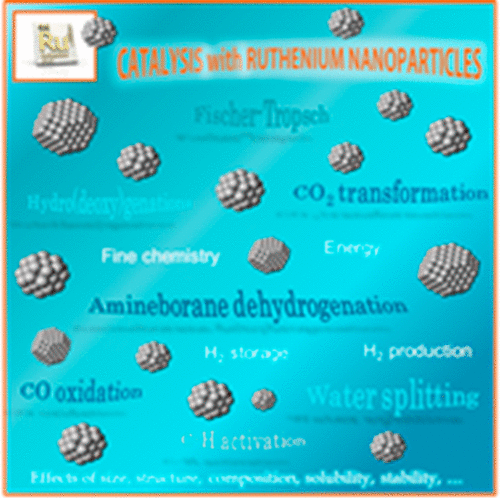当前位置:
X-MOL 学术
›
Chem. Rev.
›
论文详情
Our official English website, www.x-mol.net, welcomes your
feedback! (Note: you will need to create a separate account there.)
Catalysis with Colloidal Ruthenium Nanoparticles.
Chemical Reviews ( IF 51.4 ) Pub Date : 2020-01-03 , DOI: 10.1021/acs.chemrev.9b00434 M Rosa Axet 1 , Karine Philippot 1
Chemical Reviews ( IF 51.4 ) Pub Date : 2020-01-03 , DOI: 10.1021/acs.chemrev.9b00434 M Rosa Axet 1 , Karine Philippot 1
Affiliation

|
This review provides a synthetic overview of the recent research advancements addressing the topic of catalysis with colloidal ruthenium metal nanoparticles through the last five years. The aim is to enlighten the interest of ruthenium metal at the nanoscale for a selection of catalytic reactions performed in solution condition. The recent progress in nanochemistry allowed providing well-controlled ruthenium nanoparticles which served as models and allowed study of how their characteristics influence their catalytic properties. Although this parameter is not enough often taken into consideration the surface chemistry of ruthenium nanoparticles starts to be better understood. This offers thus a strong basis to better apprehend catalytic processes on the metal surface and also explore how these can be affected by the stabilizing molecules as well as the ruthenium crystallographic structure. Ruthenium nanoparticles have been reported for their application as catalysts in solution for diverse reactions. The main ones are reduction, oxidation, Fischer-Tropsch, C-H activation, CO2 transformation, and hydrogen production through amine borane dehydrogenation or water-splitting reactions, which will be reviewed here. Results obtained showed that ruthenium nanoparticles can be highly performant in these reactions, but efforts are still required in order to be able to rationalize the results. Beside their catalytic performance, ruthenium nanocatalysts are very good models in order to investigate key parameters for a better controlled nanocatalysis. This is a challenging but fundamental task in order to develop more efficient catalytic systems, namely more active and more selective catalysts able to work in mild conditions.
中文翻译:

胶态钌纳米颗粒的催化。
这篇综述综述了最近五年来解决胶体钌金属纳米颗粒催化问题的最新研究进展。目的是启发人们选择纳米级的钌金属用于选择在溶液条件下进行的催化反应。纳米化学的最新进展使人们可以提供可控的钌纳米颗粒作为模型,并可以研究其特性如何影响其催化性能。尽管经常不考虑此参数,但人们开始更好地了解钌纳米颗粒的表面化学性质。因此,这为更好地理解金属表面上的催化过程提供了坚实的基础,并且还探索了稳定分子和钌晶体结构如何影响这些催化过程。据报道,钌纳米颗粒在各种反应溶液中用作催化剂。主要的反应是还原,氧化,费-托反应,CH活化,CO2转化以及通过胺硼烷脱氢或水分解反应产生的氢,这些将在这里进行综述。所获得的结果表明,钌纳米颗粒在这些反应中可能具有很高的性能,但仍需要努力才能使结果合理化。除了催化性能,钌纳米催化剂是非常好的模型,用于研究关键参数以获得更好的可控纳米催化。为了开发更有效的催化体系,这是具有挑战性但基本的任务,即能够在温和条件下工作的更具活性和选择性的催化剂。
更新日期:2020-01-04
中文翻译:

胶态钌纳米颗粒的催化。
这篇综述综述了最近五年来解决胶体钌金属纳米颗粒催化问题的最新研究进展。目的是启发人们选择纳米级的钌金属用于选择在溶液条件下进行的催化反应。纳米化学的最新进展使人们可以提供可控的钌纳米颗粒作为模型,并可以研究其特性如何影响其催化性能。尽管经常不考虑此参数,但人们开始更好地了解钌纳米颗粒的表面化学性质。因此,这为更好地理解金属表面上的催化过程提供了坚实的基础,并且还探索了稳定分子和钌晶体结构如何影响这些催化过程。据报道,钌纳米颗粒在各种反应溶液中用作催化剂。主要的反应是还原,氧化,费-托反应,CH活化,CO2转化以及通过胺硼烷脱氢或水分解反应产生的氢,这些将在这里进行综述。所获得的结果表明,钌纳米颗粒在这些反应中可能具有很高的性能,但仍需要努力才能使结果合理化。除了催化性能,钌纳米催化剂是非常好的模型,用于研究关键参数以获得更好的可控纳米催化。为了开发更有效的催化体系,这是具有挑战性但基本的任务,即能够在温和条件下工作的更具活性和选择性的催化剂。











































 京公网安备 11010802027423号
京公网安备 11010802027423号